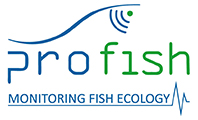Fish Stocking Success Assessments
Many wild fish populations are more or less regularly supplemented by stocking programs. Due to the costs of these programs, it is often of interest to determine the (long-term) success of such measures.
To do so, the proportion of stocked fish in the adult wild population can be determined through a variety of our techniques. If this ratio and the number of restocked fish in the water is known, it is also possible to deduce the size of the wild fish stock.
In rivers, the joint application of RFID fish detection systems and fish counters is suitable for this purpose. As an alternative to fish counting systems, control fishings can also be carried out, especially in small waters. In both cases, stocked fish are being marked with PIT tags upon their release to facilitate the distinguishment of wild and stocked fish.
If the latter is not applicable due to the size or the stage (eggs) of the stocked fish, the use of special chemical markers is also possible. Particularly suitable for this purpose is oxytetracycline, a fluroezszence marker that can be easily detected in the calcified tissue of fish. At the same time, its antibiotic effect increases the survival rate of the released fish.
Profish masteres these technologies since a long time and has also has the statistical expertise for these projects. If you have any questions, feel free to contact us!
Current References
- 2016: Population assessment through Tag-Recovery and Mark-Recapture studies. A review prepared on behalf of the Thünen Institute of Baltic Sea Fisheries.




 Partager ce contenu
Partager ce contenu